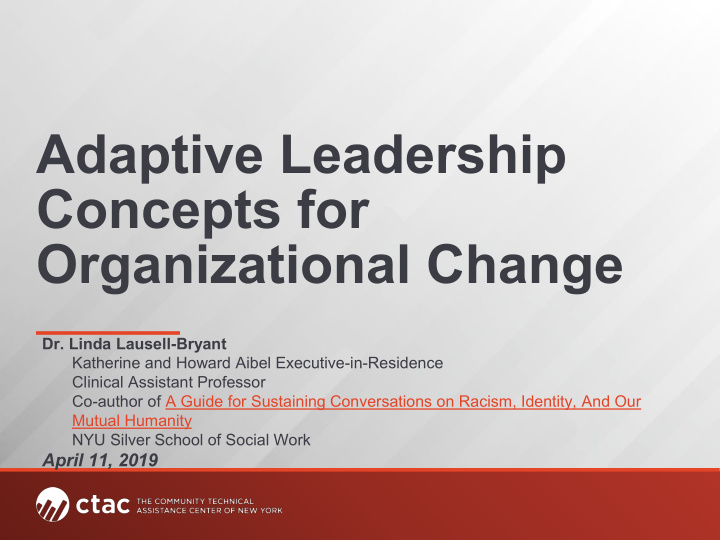



Adaptive Leadership Concepts for Organizational Change Dr. Linda Lausell-Bryant Katherine and Howard Aibel Executive-in-Residence Clinical Assistant Professor Co-author of A Guide for Sustaining Conversations on Racism, Identity, And Our Mutual Humanity NYU Silver School of Social Work April 11, 2019
Agenda ‣ Welcome! ‣ What is Leadership? ‣ What is Adaptive Leadership? ‣ Why Adaptive Leadership is Important ‣ Authority/ Leadership ‣ Challenges ‣ Qualities of Adaptive Leaders ‣ Q&A
Clearing Our Leadership Lens ‣ What is leadership? ‣ How do you define it? ‣ Please chat in your answer in the ’Chat Box’
Try This… “Leadership is disappointing your own people at a rate they can absorb.” Ronald Heifetz & Marty Linsky
Leadership Is AND Isn’t ‣ Leadership is activity ‣ It is not about the position or role of leader ‣ People with the position can fail to exercise leadership ‣ What we typically refer to as leadership is really authority
Follow the Leader!
Unless/Until…
What is Adaptive Leadership? ‣ The adaptive leadership model is designed to assist organizations and individuals in dealing with consequential changes in uncertain times, when no clear answers are forthcoming. ‣ Adaptive leaders identify and deal with systemic change, using techniques that confront the status quo and identify adaptive and technical challenges.
Remember This?
The Imperative of Adaptation For change to happen in an organization, it must: ‣ Identify what (practices or systems) are working and preserve them ‣ Identify what is NOT working and discard those practices ‣ (AND THE WISDOM TO KNOW THE DIFFERENCE) ‣ Learn new practices and approaches ‣ ACCOMPANY PEOPLE THROUGH THE LOSS AT A RATE THEY CAN STAND
Authority Vs Leadership Authority Authority Leadership Leadership Role or position Activity Protection Something you do rather than a posit Direction Anyone can take up leaders Order
Authority & Leadership Authority: ‣ Authority is given (and can be taken away) ‣ Following a known path ‣ Preserving what works ‣ Maintaining the status quo (not always bad) Leadership: ‣ Leadership is never given, but rather is taken ‣ Discarding what doesn’t work ‣ Challenges the status quo ‣ Pushes the boundaries of our authority ‣ Is dangerous, requires purpose
Technical Challenges • Tried, tested, and true • Known solution leads to an expected result • Answers found by applying existing knowledge and expertise • Goes well with authority
Adaptive Challenges • Requires changes in values, attitudes and practices • Conflicts in values between stakeholders • Root issues/elephants in the room • Loss and resistance in the face of necessary change • (change you seek up against a countervailing force) • Take time, no quick easy fixes from authority • Technical solutions won’t work
Diagnosing the System ‣ Who are the stakeholders in the system? ‣ What are their values and loyalties? ‣ What do they stand to lose if change happens? ‣ Let’s Chat: Think about a change you are trying to create and answer these questions!
Running Experiments ‣ Since there are no easy answers and we don’t have the answer, we can ‘experiment’ with interventions to see what might work ‣ Through experimentation, we’ll understand more about the system and its stakeholders ‣ We can continue to refine our experiments with new data
Qualities of Adaptive Leaders ‣ The ability to link organizational change to the primary values, abilities, and dreams of the stakeholders involved. ‣ The capacity to create an environment that embraces diversity of views and takes advantage of such collective knowledge to benefit the organization. ‣ The adaptive leader understands that change can be a painful process. Therefore, he or she can foresee and counteract any reluctant behavior from teammates. ‣ An understanding that large-scale change is a gradual process, which calls for persistence and a willingness to bear the pressure that comes along with that.
Qualities of Adaptive Leaders ‣ Being proactive, looking for opportunities and investing the necessary resources to go after them. ‣ Admitting when they make mistakes and changing or abandoning non- productive strategies. ‣ Being open to experimentation and risk-taking ‣ Liking and encouraging innovation among employees.
Let’s Chat!! What do you think? Please chat in your questions or concerns in the ‘Chat Box’!
Resources ‣ Heifetz, R., Kania, J. and Kramer, M. (2004, Winter). Leading boldly. Stanford Social Innovation Review, 21-31 ‣ Shively, Stacey. (2017). Adaptive Leadership, What is it really? http://cambridgeleadership.com/adaptive-leadership-what-is-it- really/ ‣ Heifetz, R.A., Grashow, A., & Linsky, M. (2009). The practice of adaptive leadership: Tools and tactics for changing your organization and the world. Boston MA: Harvard Business Press. ‣ Heifetz, R.A., & Linsky, M. (2002). Leadership on the line: Staying alive through the dangers of leading. Boston, MA: Harvard Business School Press.
Upcoming CTAC Events ‣ The Importance of Parent Involvement in Child Welfare – 4/25 at 12 PM ‣ Empowering Recovery and Resilience with Mindfulness – 4/30 at 12 PM
Contact Us! Please contact us with any questions and/or concerns! ctac.info@nyu.edu
Recommend
More recommend